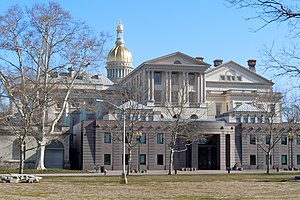Government of New Jersey | |
|---|---|
| Polity type | Sub-national administrative division (federated state) |
| Part of | United States of America |
| Constitution | Constitution of New Jersey |
| Legislative branch | |
| Name | Legislature |
| Type | Bicameral |
| Meeting place | New Jersey State House |
| Upper house | |
| Name | Senate |
| Presiding officer | Nicholas Scutari, President |
| Lower house | |
| Name | General Assembly |
| Presiding officer | Craig Coughlin, Speaker |
| Executive branch | |
| Head of state and government | |
| Title | Governor |
| Currently | Phil Murphy |
| Appointer | Election |
| Cabinet | |
| Name | New Jersey Cabinet |
| Leader | Governor |
| Deputy leader | Lieutenant Governor |
| Headquarters | State House |
| Judicial branch | |
| Name | Judiciary of New Jersey |
| Courts | Courts of New Jersey |
| Supreme Court of New Jersey | |
| Chief judge | Stuart Rabner |
| Seat | Richard J. Hughes Justice Complex, Trenton |

The government of the State of New Jersey is separated into three distinct branches: legislative, executive, and judicial. The powers of the State of New Jersey are vested by the Constitution of New Jersey, enacted in 1947, in a bicameral state legislature (consisting of the General Assembly and Senate), the Governor, and the state courts, headed the New Jersey Supreme Court. The powers and duties of these branches are further defined by acts of the state legislature, including the creation of executive departments and courts inferior to the Supreme Court.
Like most states, the state allows the incorporation of county, and other local municipal governments. The state capital is located in Trenton.
